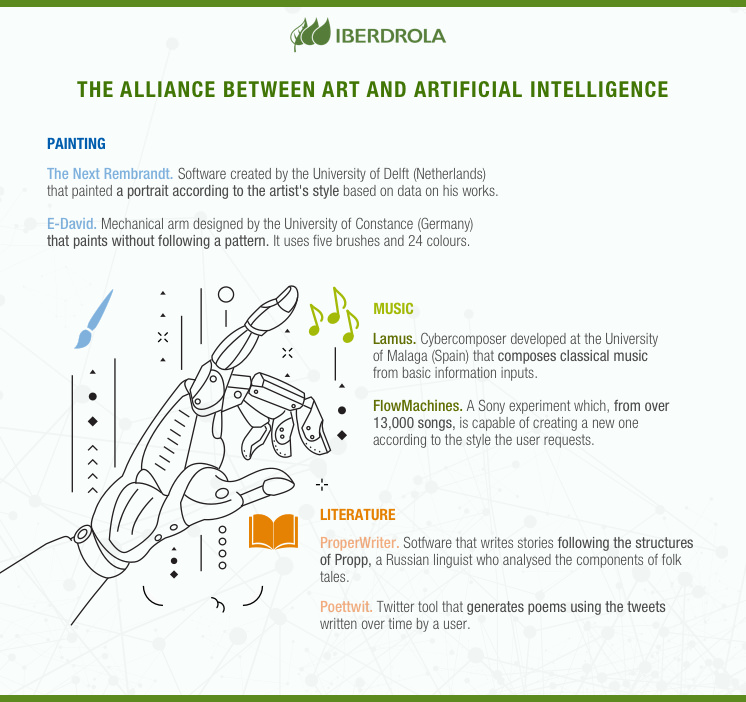WHAT IS COMPUTATIONAL ART?
Can machines create art?
Until not long ago, art was a skill inherent to the human being, and therefore, inaccessible to machines. The appearance and evolution of Artificial Intelligence forces us to reconsider whether painting, composing or writing is still the exclusive heritage of humanity. The debate is now open.

Art, according to the Real Academia Española (RAE), is the "manifestation of human activity through which the real is interpreted or the imagined is captured with physical, linguistic or sound resources." Although an unavoidable reference for the good use of language, the fact is that the RAE was created in 1713, when machines, as we think of them today, were unthought of.
Much progress has been made since then and machines today, in the form of sophisticated software, are already capable of writing a poem, composing a song or painting a picture. The question is: is that art? As always, it depends on the angle from which you look at it, and one of those perspectives is that provided by Margaret Boden. For this British philosopher there are three types of creativity: the combinational, that mixes existing ideas; the exploratory, that generates new ideas by exploring conceptual areas; and the transformational, that breaks down previous structures and creates new areas. Boden argues that machines can be competent in the first two cases, but for the third, at least for now, a human mind is needed. In any event, the debate is on.
The concept of computational art limits the discussion to an extent. It is defined as the study and simulation of natural human creative behaviour, by means of computer programs. Such a concept is applied to musical, artistic and literary creation by means of Artificial Intelligence (AI), in other words, the recreation of human creativity by a computer. Under this concept, robots can create art. In fact, only a few months ago, Christie's held the first auction of art created by Artificial Intelligence. What was the outcome? Sales of approximately 432,500 dollars.
ARTIFICIAL INTELLIGENCE AS AN ART TOOL
Like everything else concerning Artificial Intelligence, no one knows for sure how this technology will evolve in the future. However, more and more experts theorize about a new relationship between man and machine focused on collaboration and less on the prevalence of one over the other. "Artificial Intelligence is a tool, just like a paint brush is, and in the future it will help humans create interesting works of art", says Bas Korsten, Executive Creative Director at J. Walter Thompson.
Along the same lines, Aaron Hertzmann, Professor at the University of Toronto and principal investigator at Adobe Research, said the following: "Computation creativity is an amplifier of the imagination: having better tools for creativity will allow more people to create and artists to go much further than they could go on their own."

ARTIST ROBOTS
Large technology companies, such as Google, are already exploring the field of art and robotics. The first two ventures of the American giant are the Magenta and Deep Dream projects. The latter, in particular, is based on image recognition software that identifies objects and applies filters to them in order to reinterpret them artistically by simulating watercolour, comic or charcoal techniques.
Computation creativity not only lives from painting. The machines are also capable of composing music, such as the one created by Grammy winner Alex Da Kid using an Artificial Intelligence system. For five years, this musician — or rather, his software — analysed newspaper articles, Wikipedia entries, film synopses, song lyrics and chord progressions until finding the most popular themes and rhythms. With all of this he composed Not easy, his first cognitive song. Poetry is not spared either. WASP (Wishful Automatic Spanish Poet) is an automatic poet developed by Pablo Gervás, Professor at the Complutense University of Madrid, which is given instructions on metrics and rhyme, is told to be inspired by the work of a poet and begins to compose verses on its own.
In these latter cases, human intervention, although almost token, does exist. But there are also samples of computer art alien to human participation. Two examples. Memory of a passer-by, a piece by Mario Klingermann, a German artist, consisting of two screens that emit a constant flow of images with faces distorted by algorithms through an Artificial Intelligence brain. The interesting thing is, none of those faces ever existed! The other, with a different nuance, is The painting fool. This software or artist robot, created by Simon Colton, Professor at the University of London, downloads images from the Internet, catalogues them around concepts such as joy, desolation or panic and applies that learning to create digital works inspired by those emotions.
The value of emotions versus robotisation




